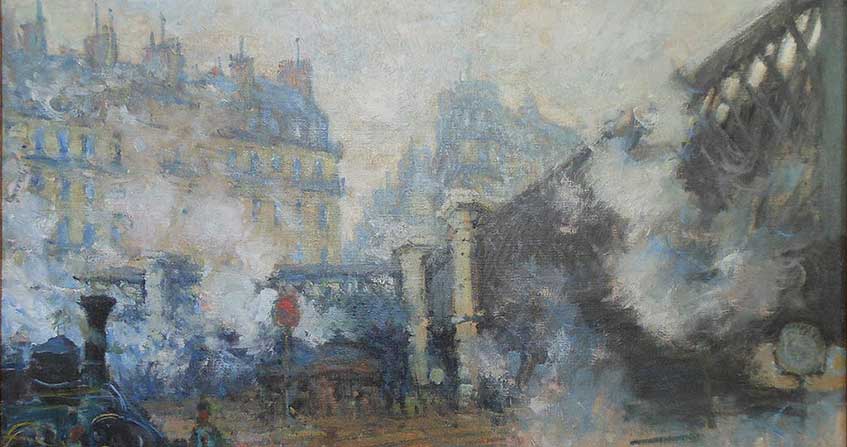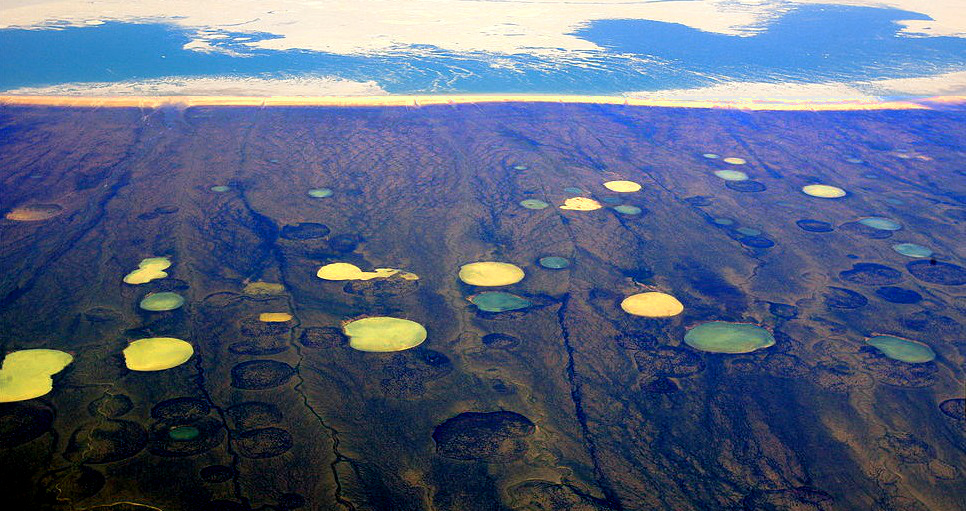The laws governing the activity of volcanoes
PDF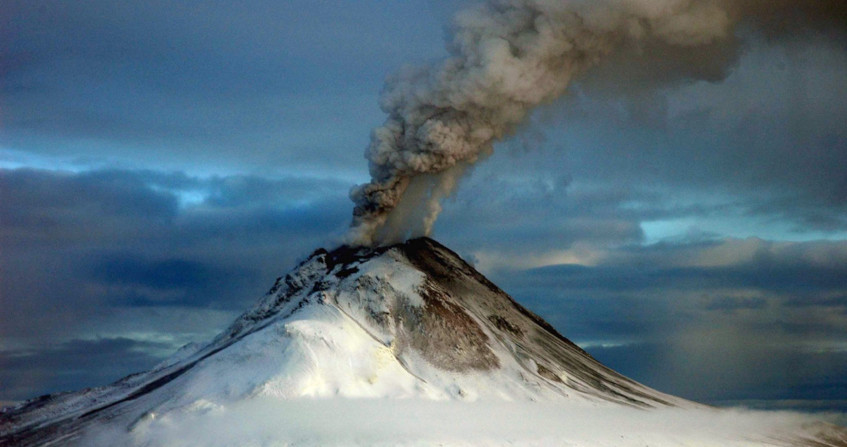
Where on Earth are there volcanoes? Why and how do volcanoes erupt? Why are they capable of erupting in very different ways? To answer these questions, magmas must be tracked from their source tens of kilometres down to the surface. It all starts in the Earth’s mantle, beneath the crust, whose movements are responsible for the formation of magma. Because it is lighter than the surrounding rocks, magma is pulled out of its source and rises to the surface. It often accumulates in a reservoir. There it cools, crystallizes, changes its composition and physical properties, to the point of increasing its concentration of volatile elements. A volcanic reservoir is not stable and eventually releases the magma it contains. When the magma is pushed to the surface, it degasses. Depending on the amount of gas released, an eruption can take the form of a liquid flow or a gas jet carrying fragments of magma at high speed. Much progress has been made in volcano physics, but many uncertainties still limit the experts’ predictions.
1. How a volcano is built
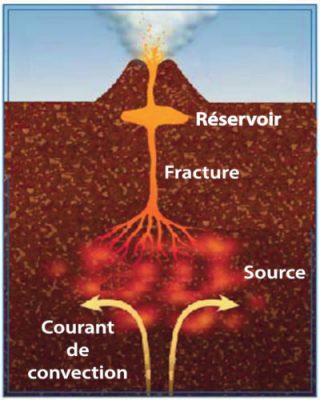
Magma rises to the surface because it is lighter than the surrounding rocks. When it encounters formations that are less dense or particularly resistant to deformation, it stops and accumulates in a reservoir. While in the reservoir, this magma cools and partially crystallizes, leaving minerals and residual magma whose composition changes as crystallization progresses. This mechanism is responsible for the wide variety of magmas and eruptive regimes on Earth. A reservoir is not stable and eventually fractures, allowing the magma to resume its ascent to the surface. It is in this last phase that the regime of an eruption is established. The last part of the volcanic system is the edifice itself, which can rise to several kilometres in altitude and which can undergo far-reaching changes.
Volcanoes can remain active for hundreds of thousands of years and can rise several kilometres in altitude. The age of Etna in Sicily, for example, is estimated at half a million years. The largest volcano on Earth is Mauna Kea on the island of Hawaii, which remained active for nearly a million years and is now extinct. Its summit rises almost ten kilometres above the seabed.
2. The sources of volcanoes
Outside its core, the Earth is essentially solid and produces magma only in a few specific places. As it cools, its mantle is driven by large convection movements [3] with speeds ranging from a few centimetres to a few tens of centimetres per year. These movements take two different forms: large cells associated with plate movements [4], which are responsible for the expansion of the ocean floor and continental drift, and localized, approximately cylindrical upward currents called plumes or hot spots [5].
Mantle rocks are assemblages of minerals and are not pure bodies. Melting does not take place at a given temperature and takes place over a temperature range from the solidus [6], which marks the appearance of a liquid, to the liquidus [7], which sees the last solid disappear. On Earth, it can occur in two very different ways.
2.1. Decompression melting
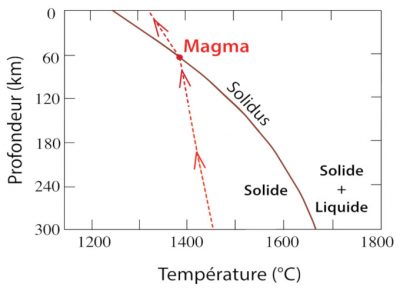
This mechanism is responsible for two types of volcanoes (Figure 3). The first are associated with the upward currents of convection cells, which are materialized at the surface by ridges [8] running across the ocean floor. These volcanoes are little known because they are located more than two kilometers under the sea, but they are responsible for the largest amount of lava [9] produced on Earth. Volcanoes of the second type are the largest, such as those in Hawaii and Reunion Island, and are due to mantle plumes (also called hot spots).
2.2. Fusion by hydration
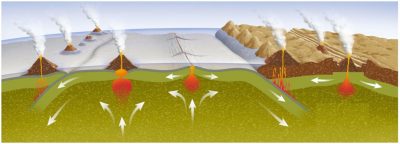
2.3. The distribution of volcanoes on Earth
Other mechanisms are at work on Earth, for example within a thickened continental crust or in an extension zone, but are not responsible for large amounts of magma on a global scale. In any case, the ultimate cause of volcanism lies in the internal movements of the Earth’s mantle that develop over thousands of kilometres (Figure 3). Magma is produced as it rises and falls. Volcanoes are markers of global activity and can be considered permanent on a human scale.
3. The rise of magmas
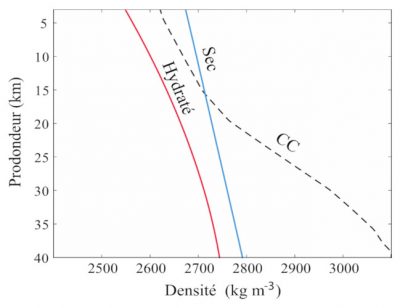
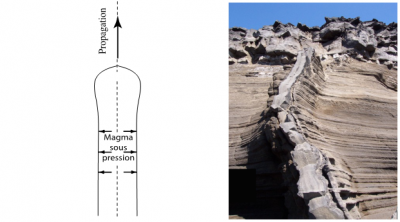
4. Volcanic reservoirs and their magmas
Magmas are complex liquids made of many oxides, of which the oxides of Silicon (SiO2), Iron (FeO and Fe2O3) and Aluminium (Al2O3) are the most abundant. A magma can be produced by the partial melting of a rock or by partial crystallization of a more “primitive” magma. Its chemical composition dictates its physical properties and therefore the eruptive conditions.
4.1. The formation of volcanic reservoirs
“Primitive” magma can rise as long as it is lighter than the rocks it encounters and as long as it is able to fracture them. Near the surface (Figure 4), rocks are often less dense than this magma, either because they are of sedimentary origin or because they are fractured. When the magma reaches them, the Archimedean force changes sign and opposes the ascent. Elsewhere, rocks denser than the magma and particularly resistant to deformation can prevent the magma from passing. In both cases, a reservoir forms below the surface.
A reservoir plays a fundamental role. Fed by a deep source with a low flow rate, it serves as a magma accumulator and allows very large volumes to erupt quickly. In addition, it acts as a chemical reactor where the magma changes composition.
4.2. The manufacture of “advanced” magmas
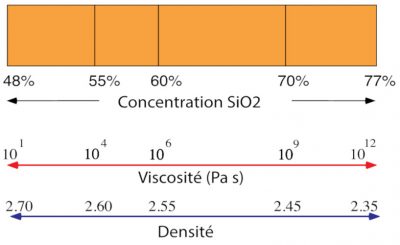
A magma reservoir is capable of generating eruptions in a closed system, but can also be replenished by primitive magma. It can undergo complex changes in chemical composition depending on the sequence of re-injection and eruption. Residual magma may tend towards evolved compositions and then return to more primitive compositions.
4.3. Viscosity of magmas
A basalt is a hundred times more viscous than cooking oil, which is itself a hundred times more viscous than water. A remarkable fact is the enormous variation in the viscosity of magmas, shown in Figure 6 for those that are dry, i.e. without water. Between a basalt and a rhyolite [14], the viscosity increases by more than ten orders of magnitude! An extremely viscous magma such as rhyolite flows very slowly and has a fundamentally different behavior from that of a basalt. Thus, the same volcano can produce very different eruptions when the composition of the magma changes.
4.4. Volatile species and volcanic gases
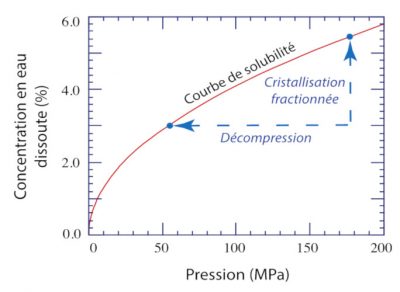
4.5. The rupture of the reservoir
For a blowout to occur, the reservoir must release the magma it contains, which can be due to two phenomena. The first is the injection of mag ma from the source, which is constantly active. The reservoir swells until its walls can no longer withstand the stress. The second phenomenon is crystallization. Volatile elements that are in solution in the primitive magma cannot be taken up by the crystals with very few exceptions. As a result, they become enriched in the residual liquid as crystallization progresses. When their concentration finally reaches the solubility threshold, the magma is saturated and a gaseous phase appears. From that moment on, the reservoir contains a mixture of magma and gas bubbles, whose density is much lower than that of the original magma. At constant mass, the decrease in density causes the volume to increase and thus the reservoir to swell.
In both cases, the inflation of the tank signals that a blowout is in the making. It results in a ground lift at the surface, the amplitude of which is usually several centimetres. Such deformation is easily measurable with today’s tools.
5. The main eruptive regimes
5.1. Two main categories of eruption
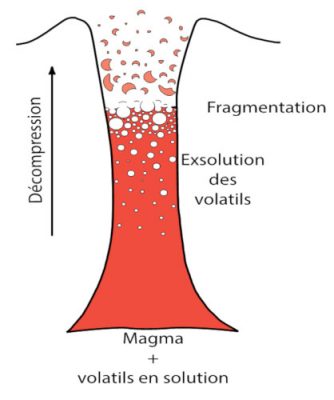
5.2. Two “explosive” regimes
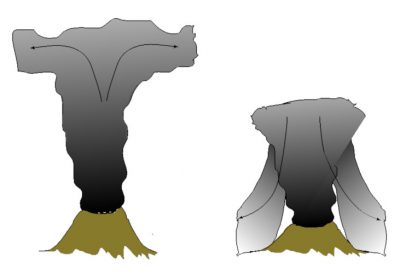
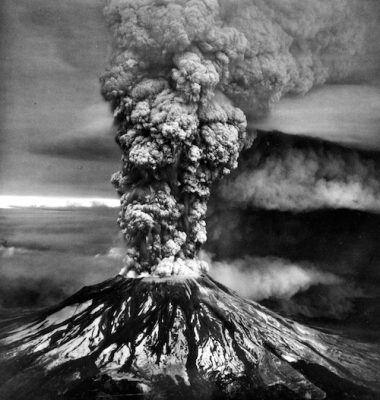
The famous eruption of Vesuvius in 79, which destroyed the Roman cities of Pompei and Herculaneum, shows that untimely changes in eruptive regimes can occur. The volcano started in a Plinian regime, which is unpleasant and destructive in the long term but not fatal for the people. It changed regime abruptly and began to emit violent and deadly pyroclastic flows.
Video 1: Example of an atmospheric column of gas and ash that develops during an explosive eruption. [Source: Ashraf Bouiafri]
5.3. The role of turbulence
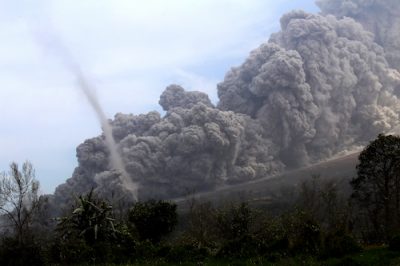
An important consequence of the low amount of volatiles in the magmas is that the mixture escaping from a volcano is denser than the atmosphere in any state. Without an increase in the amount of gas, this mixture cannot rise to high altitude. Under these conditions, how can Plinian eruptions be produced?
Video 2: Example of pyroclastic flow at Sinabung volcano in Indonesia [Source: Marc -Volcano – Szeglat]
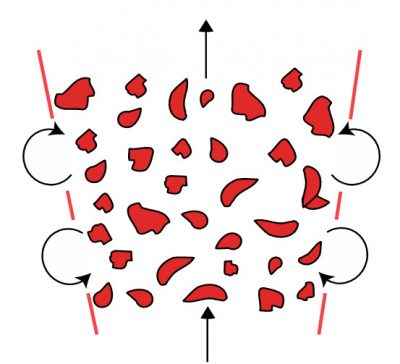
The origin of the two explosive regimes is to be found in the behaviour of the eruptive column as it rises in the atmosphere (Figure 10). The flow is fast and in a turbulent regime, such that vortices incorporate air into the column (Figure 12). The mixture becomes progressively lighter. As long as it is heavier than air, it slows down under the action of its weight. If its rate of ascent falls to zero, it falls back to the ground near the outlet. This is the regime of pyroclastic flows (Figure 9). If the amount of air ingested by the column is large, the volcanic mixture eventually becomes lighter than air. In this case, it is propelled upwards by Archimedes’ thrust. This is the Plinian regime (Figure 9). An eruptive column that produces pyroclastic flows rarely exceeds a few kilometers in altitude, whereas those of the Plinian regime can exceed 20 kilometers.
5.4. Lava flow eruptions
Lava flows are of several types depending on the viscosity of the lava and the slope of the volcano. Basaltic eruptions can form vast lava fields over extremely large distances, even on horizontal ground. Lava flows on the Columbia Plateau in western North America have travelled several hundred kilometres. More viscous lavas, such as dacites and rhyolites (Figure 6), do not spread much and form thick flows over the eruptive conduit. These are called “lava domes“. In 1980, the lava dome at Mount St. Helens, Washington State, USA, reached a thickness of 300 meters.
Video 3: Example of a lava flow eruption and growth of a lava dome on the Chiveloutch volcano in Russia. [Source: Newsfalre]
5.5. Some other rash regimes
Basaltic volcanoes have two particular explosive eruptive regimes of lower intensity. In a lava fountain, the flow in the conduit takes the form of a central gas jet that pulls up a film of liquid lining the edges. At the outlet, the result is a spectacular wall of lava that can rise several hundred metres high. Fountains of lava are common at Etna in Sicily and at the Kilauea volcano in Hawaii. Strombolian explosions are an extreme case with a very low lava flow. These are mostly gaseous eruptions, caused by the explosion of large pockets of volcanic gas. The eruptive conduit is saturated with lava and can remain open for several years. As the name suggests, these eruptions are common on the island of Stromboli off the coast of Naples.
The “fiery clouds“, made famous by the catastrophic eruption of Mount Pelee in 1902, are pyroclastic flows (Figure 11). They are formed by the explosion of a lava dome, and are characterized by a mixture of pieces of the solidified shell of the dome and fragments of liquid magma from the core of the dome. They are shorter and have smaller volumes than those resulting from the collapse of an atmospheric column. It was flows of this type that destroyed the city of Saint-Pierre de Martinique during the eruption of Mount Pelée in 1902.
Phreatic eruptions, as opposed to previous eruptions, do not eject magma, but only fragments of the volcanic edifice and its bedrock. The magma plays an indirect role in these eruptions by heating and vaporizing the water contained in the surrounding rocks. These eruptions can throw huge boulders and often precede a magmatic eruption itself.
6. The volcanic edifice
In the continents or island arcs at the edge of the oceans, the buildings are more modest but can still rise to several kilometres in altitude.
Such important buildings change the eruption conditions. First of all, the magmas have to travel an additional distance to reach the exit point. The density of the magma once again plays a vital role. The higher it is, the harder it is to climb to the summit. In some cases it is no longer possible and the eruption takes place on the sides of the volcano. A second effect is that the edifice induces a compressive stress field in the superficial parts of the volcanic base. These stresses can become strong enough to divert the dykes, which stop their vertical progression and inject themselves laterally. Beyond a certain distance from the edifice, the magma returns to an undisturbed environment and resumes its ascent, forming satellite cones.
A volcanic edifice is fragile. Under the effect of deformation due to the magma that penetrates it, it can be destabilized and collapse. The magma within it decompresses and expands abruptly, creating a destructive surge. This is what happened at the beginning of the 1980 eruption of Mount St Helens in Washington State, USA.
7. Knowledge and uncertainty assessment
The physics of volcanoes has developed considerably over the last forty years. The main mechanisms involved can be considered to have been identified and understood, but there are still major gaps in our knowledge. The damage caused by an eruption depends primarily on the total volume that is ejected and its duration, and these are still variables that can only be measured after the fact. Neither the dimensions of the magma reservoirs nor the composition of the magma(s) they contain are precisely known. The eruptions often undergo regime changes, alternating for example between Plinian phases and pyroclastic flows and ending with the emission of lava flows. Taken individually, these regimes are understood, but the complete eruptive sequence is not. All these questions seem to be out of reach at the present time and can probably only be answered by the development of fine imaging methods to follow the course of an eruption at its source, in and out of the magma reservoir.
8. Messages to remember
- Magmas are produced continuously on Earth and do not stay deep for long.
- Volcanoes are located in a few specific places, linked to the internal activity of the planet.
- The magmas rise to the surface on their own, under the effect of Archimedes’ thrust.
- Magmas of very different compositions and physical properties are produced by partial crystallization in reservoirs.
- The regime of an eruption depends on the physical properties of the magma and its water content.
- At high gas concentrations, the eruption takes the form of a turbulent atmospheric column carrying pulverized magma.
Notes and References
Cover image. January 2006 eruption of Augustine Volcano, Alaska [Source: Credit: United States Geological Survey, public domain http://www.avo.alaska.edu/image_full.php?id=5927].
[1] A magma is a liquid produced by the fusion of a rock.
[2] The Earth’s mantle is the layer that occupies the largest volume in the Earth, between the base of the crust and the earth’s core at a depth of almost 2900 kilometres.
[3] The phenomenon of convection describes the movements that occur spontaneously in a fluid when its density varies spatially, for example when it is cooled from above.
[4] Plates are the large rigid surface units that move across the surface of the Earth.
[5] Plumes, or hot spots, are localized updrafts of approximately circular cross-section that are generated by a small source.
[6] The solidus is the temperature at which a solid starts to melt.
[7] Liquidus is the temperature at which a solid is completely melted.
[8] Ocean ridges are underwater mountain ranges in the middle of the oceans. They are the mark of the ascending parts of the convection cells in the mantle.
[9] Lava is the name given to the liquid that escapes from a volcano. It is made of magma containing varying amounts of gas bubbles and crystals.
[10] Subduction zones are the places where the plates sink into the Earth’s interior. They mark the downdrafts of the convection cells of the Earth’s mantle.
[11] Archimedes’ thrust is the force that is exerted on a volume that is lighter than the fluid that surrounds it.
[12] The word basalt refers to the magmas that are formed by partial fusion of the rocks of the earth’s mantle when the fusion rate does not exceed 30%.
[13] A dyke is a crack that is opened by pressurized magma.
[14] Rhyolite is the magma that forms at the end of the basalt crystallization sequence.
[15] The adjective pyroclastic refers to “pyroclasts”, which are fragments of magma (the word comes from “pyro” which means on fire and “clast” which means rock fragment).
The Encyclopedia of the Environment by the Association des Encyclopédies de l'Environnement et de l'Énergie (www.a3e.fr), contractually linked to the University of Grenoble Alpes and Grenoble INP, and sponsored by the French Academy of Sciences.
To cite this article: JAUPART Claude (August 30, 2021), The laws governing the activity of volcanoes, Encyclopedia of the Environment, Accessed April 26, 2024 [online ISSN 2555-0950] url : https://www.encyclopedie-environnement.org/en/soil/laws-governing-activity-volcanoes/.
The articles in the Encyclopedia of the Environment are made available under the terms of the Creative Commons BY-NC-SA license, which authorizes reproduction subject to: citing the source, not making commercial use of them, sharing identical initial conditions, reproducing at each reuse or distribution the mention of this Creative Commons BY-NC-SA license.





